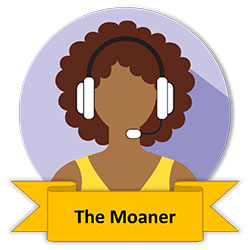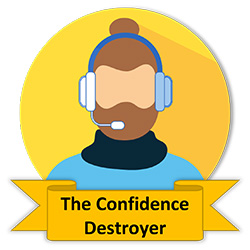Have you ever worked somewhere that you just knew was a toxic environment? Or worked with someone who you thought was toxic?
Maybe you just didn’t get on with that workplace or colleague.
Thinking back, could you pinpoint what made it or them toxic?
The majority of people will have a story or two about when they’ve worked in such an environment, or maybe worked with somebody who just made their job unbearable. Some people may even tell you they left a job to get away from a toxic manager!
Before we start, there are two different definitions I would like to share with you:
Toxic Workplace
A toxic workplace is defined as workplace bullying and harassment, which can include behaviour that makes someone feel intimidated or offended. (Source: Indeed)
Toxic Employee
A toxic employee is somebody who exhibits negative behaviour which is detrimental to the team, department, or organization. Toxic employees can exhibit this behaviour in either a physical or verbal method.
In this article, I’ll help you to understand the different types of toxicity and give you some actionable steps which you can use straight away and some guidance on what to do long term to heal the toxic environment.
Handling These Types of Behaviour in Contact Centres
Contact centres can be amazing places to work, they can be empowering and rewarding for people who have the right mindset. When you put toxic employees in the mix, they can destroy the harmony of a well-run contact centre and create a toxic environment.
So, while you are reading this, are you thinking you might know somebody who is toxic? They could be the nicest person in the world, but when they are at work you describe them as ‘a nightmare’.
The first step is to recognize what behaviours are creating the toxicity. When you understand that, you can put steps in place to counteract them and heal the environment.
Recognizing a Toxic Employee
There are several types of toxic employee. In this article I’ll focus on six:

1. The Moaner
You know the type. This is the person who complains about everything.
It doesn’t matter what it is, they will find a fault with it, and they will tell others about all the shortcomings of the idea.
I have seen this before when a company brought in free fruit. The majority of people thought this was great.
The ‘moaners’ complained about the lack of selection.
What it’s like to work with the moaner:
- They can sap the joy out of the room; you may get a feeling of dread if you know you’ll be working with them.
- They can be a pessimist. Working alongside somebody who is always looking at the negative can have a dramatic effect on your mental health.

2. The Confidence Destroyer
This person sits at the back of the meeting room and just smirks at you. It can completely throw you off your game. Or they make small comments which undermine your confidence.
They may show passive aggressive behaviour.
I’ve had these types of people in my training room many times over the years.
Outside the training room, we would be friends, but I would dread seeing their names on my roster for classroom training.
What it’s like to work with the confidence destroyer:
- They immediately put you on edge.
- You may notice your performance levels drop as you feel anxious or nervous around them.
- You may talk more than normal, in an attempt to fill the empty space and not give them time to ‘judge’ you.

3. The Glory Seeker
This person seeks approval from the managers, and they don’t care how they get it, whose toes they step on or whose ideas they steal.
This person may know exactly what they are doing, they also may see no problem with it.
I’ve seen this happen before, where ideas have been discussed over the water cooler by a group of people.
Then suddenly a few weeks later you’ll see the idea being put into practice and one person taking the credit.
What it’s like to work with the glory seeker:
- These people will stop at nothing to climb the corporate ladder.
- They will take other people’s ideas and pass them off as their own.
- When questioned about the ideas, they will often not be able to provide details.
- They may rely on other people to do the work, delegating detailed tasks and not giving credit.

4. The Wheelbarrow
This person only works when they are pushed.
They never show initiative, and only want to do the job they are paid for.
In contact centres you generally have two types of people, those who want to progress and those who don’t care, they just arrive, do their job, and then go home.
What it’s like to work with the wheelbarrow:
- These are the people who have no desire to get involved in extracurricular activities.
- They can also sometimes be confused with moaners, as you need to work extra hard to engage them.
- If you try to get them involved in team-building activities, there may be a lot of eye rolling and muttering about being forced to participate.
- They can, however, be very good and focused at the task at hand.

5. The Spy
This person watches and then reports back.
You may have worked with someone like this before, the person everyone knows not to tell anything important to.
They may be seeking approval from the managers, and think if they report what they see it will reflect well on them.
What it’s like to work with the spy:
- Working with them can put you on edge, because you have to constantly think about what you are saying.
- They may be trying to use information to climb the corporate ladder.
- They may not realize what they are doing is wrong.
- Being the office gossip could be their way of feeling connected to their colleagues. They may not feel like they have any friends so gossip to connect.

6. The Micromanager
What are you doing? Why are you on wrap? Why are your calls longer than anyone else’s? How long will it take you to do this task? Why hasn’t it been done yet?
Sound familiar?
Nobody likes to work for a micromanager, to such an extent that it can make employees look for work elsewhere in another team or company.
A survey by GoodHire, which looked at 3,000 full-time workers in the USA across different industries, found that 82% of workers might quit their job because of a bad manager.
What it’s like to work with the micromanager:
- They nag, they check up, they nit-pick.
- They may say they want you to feel like you can make the decisions but then second-guess you.
- They constantly chase you for updates.
How Managers Can Deal With Toxic Employees
No workplace is toxic, the environment is a reflection of the people who work within it.
You may recognize the signs that you have a toxic employee, or another member of staff may raise it with you. It doesn’t matter how you discover them, you need to act!
The first step in healing an employee is to talk to them. They may not realize this is how they come across, and awareness is the first step to change.
Make sure you ask lots of questions, open and probing, so you can really get to the bottom of their behaviour, as there might be an underlying cause which is affecting how they behave. They may be masking a lack of confidence by picking out faults in others, for instance.
You can run through different scenarios, explaining how you would handle the situation compared to how they handled it. Make them aware of the effect they have on people and the environment.
The most important aspect of healing toxic employees is to ensure there is a clear line of communication. They need to know that they can be heard, be honest and that you empathize with them. If not, their behaviour could become worse, which could lead to complaints and disciplinary action.
What Can You Do if Your Manager Is Toxic?
As we’ve seen before, talking to them can be the first step in their self-realization of how their actions affect people.
If talking to them doesn’t work, you could consider speaking to Human Resources (HR) or their manager, depending on the set-up of your company. It may be they need some coaching on how to handle certain situations or conversations.
In Conclusion

Nobody wants to work in a toxic environment, with a toxic colleague or manager. Recognizing the signs early will help you manage the situation. Ideally, you want to heal the environment and retain the employee, because it’s much better and cheaper to keep somebody than replace them.
And if you recognize some of these traits in yourself, you’ve taken the first step to change.
Just remember, in healing the toxic employee you will heal the workplace, even if that toxic employee is you.
Written by: Kim Ellis TAP.dip, Training Consultant, LN Board Director & Chief Learning Architect at GO GINGER learning solutions.
To discover more great insights on handling contact centre agents and identifying issues, read these articles next:
- The 5 Danger Signs of Complacency in Your Contact Centre
- How to Overhaul Your Employee Engagement (EX) Strategy
- 10 Customer Service Behaviours Every Contact Centre Agent Should Have
Author: Kim Ellis
Reviewed by: Megan Jones
Published On: 2nd Jan 2023 - Last modified: 24th Sep 2025
Read more about - Call Centre Management, Employee Engagement, Health Wellbeing and Stress, Kim Ellis, Leadership, Management Strategies, Team Management




































